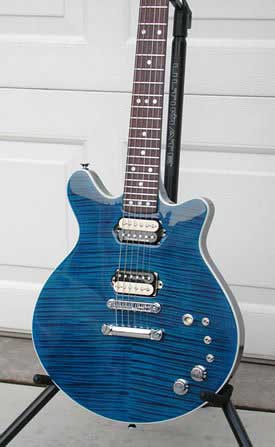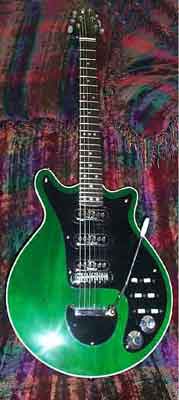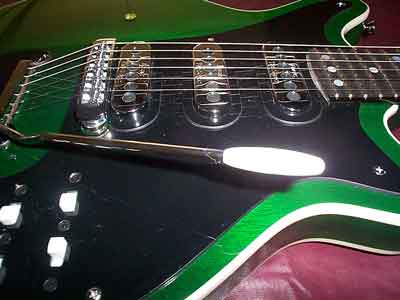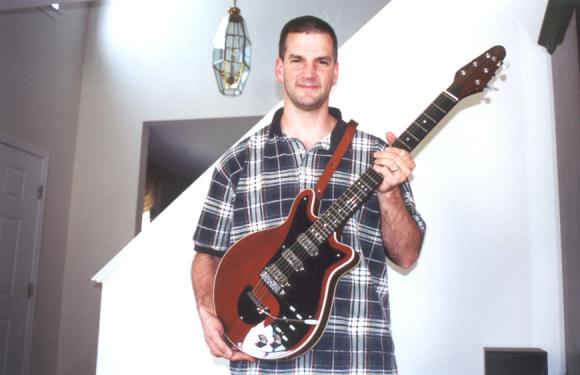
Red Special replicas
-RS Guitars reviews-
RS GUITARS
5 reviews
![]()
review by Alex Bolte (Germany):

Hi, my name is Alex Bolte; Iím from Germany and received my RS classic
a couple weeks ago. Here is a review of my thoughts about it.
First I have to say that I was insecure to order a custom made guitar
from overseas. But friends took my doubts away as they knew about the high
quality of the RS guitars and one of them knows the people from RS very
well and owns a RS Custom. (Thanks Mark and Peter). So I ordered.
First impressions
6 months later my RS classic arrived safely here, finally! I opened
the case and was really amazed at the beauty of the guitar. It came in
a black leather case of high quality. I stared at it from all sides. The
first thing I noticed was that this is really a high class instrument.
Everything is very well made. The finish is plain as glass and absolutely
flawless. The front of the headstock bears the unassuming and nice RS Guitars
logo in gold letters. The new bridge is a lot better than the previous.
Very stable, more solid and straight (The previous was a slanted). The
whole setup was fantastic right out the case. It was not even out of tune!!
Such a high quality that Iíve only seen on guitars that are at least double
the price. A real jewel.
The tremolo arm is not fixed to avoid damages during the overseas delivery.
Itís well described in the manual how to mount the tremolo arm. If this
isnít enough thereís also a drawing of it included.
Also the pickup surrounds are not mounted, as the pickup height has
to be adjusted to personal preferences first. After this the pickup surrounds
will cover the screwholes. It has to be mentioned that you have to be a
little bit handy to make the pickup surrounds fit around the pickups. Some
careful sandpaper work is required here. But this all is quite easy to
do.
Sound
I played the first chords unplugged to hear the sustain and sound character.
I was strumming a G chord. Amazing! The whole guitar seemed to vibrate
from the body to the headstock. Also the acoustic sound is a lot louder
compared to my Burns BM. Yes, this is the sustain that I missed in many
guitars I owned before. The neck profile is quite fat as the authentic
one. It takes you a while to get used to it and it really feels comfortable
but after this youíll not look back. Itís smooth to bend the strings. The
left hand is filled with the neck and feels great. On the belt over the
shoulder you notice that the RS Classic is a quite a heavy guitar. Around
3.8 kg.
I play over a Vox AC-30 TB and a Vox Valvetronix AD120 with the Fryer
Treble Booster. Here the real thing starts! Plugged in it sounds very powerful.
The sustain seems never ending. The sound is very well balanced, absolutely
clear and sweet. Playing chords above the 12th fret intonates perfectly.
All pickup combinations have their own character. The volume pot works
fantastic by rolling back. No loss of treble or dynamic at all. The tremolo
allows you to divebomb and returns to pitch perfectly. Really no comparison
to any Red special copies I played before.
Conclusion
Yes folks, I found what I was looking for. This is ďTHEĒ sound. The
waiting was worth it. Not just about the sound (I can say only good
things) but also itís looks; so beautiful.
Jeez, I always get gooseflesh when I look at it on the guitar stand
in my living room.
The e-mail contact to RS Guitars during the whole time of production
was always nice and working well. Steve Turpin was always nice and responded
to all my e-mails immediately. He kept me well informed about every building
stage. I just can state all the best.
Thanks to everyone at RS Guitars.
If you have any questions, please feel free to e-mail me: trisonic@web.de
![]()
review by Mitch Goldman (USA):
First thing i did was check out the finish and the body. The finish looks great, and i was really impressed with the neck joint. It has the smoothest, smallest heel i've ever seen on either a bolt-on or a neck-through. the slim profile is great. The length of the instrument is longer than my other guitars (while, ironically, having a shorter scale from the nut to the bridge!). The neck joins the body at like the 21st fret, which is quite high up. this gives you great access to the upper frets but in some cases could cause the neck to be less than really stiff. However the neck *seems* stiff to me...i didn't do the standard test (prop the body, grab the headstock in one hand and pull down on the middle of the neck with the other hand, both with and without strings...this usually tells you how stiff or rubbery the neck is). It may be a factor of how the frets were seated that the neck doesn't have that rubbery Gibson SG-feel. Which is good! (i'll do the stiff test when i change strings and let you know how it feels.) I love the neck through construction and how it looks, especially as it gives the axe the blue finish all the way up to the headstock.
I noticed no flaws or buffing compound residue on the guitar. So finish-wise it's all pretty flawless.

Next of course i checked the neck and its relief. Using a straightedge I found there was minimal relief from the nut to the ninth fret, and then the neck is straight from the ninth to the 24th. this is pretty much perfect! i didn't check the truss rod's effectiveness yet but will do this at the first string change. I noticed the action was set really low, as you had mentioned. The strings were a bit buzzy so i loosened the strings and raised the bridge slightly on both sides, a bit higher on the bass side. Somehow when tuning back up i popped the D string so i replaced it. I was AMAZED at the Sperzel locking tuners...they are incredible. I wish all my axes had them...i have no complaints about my PRS but the locking tuners on that (Gotoh i think) are very hard to use...they have this little arm, and a cam you have to line up. The Sperzels, with no instructions, were totally intuitive. Just twist the round knob to loosen, put the new string in, screw down the lock, and tune to pitch. I don't think i've EVER changed a string that fast!
After raising the bridge i checked the intonation. It's worth noting that only two strings were out (the D and the B) which i think is damned good for a post-bridge adjustment. I had to loosen the strings to reach the saddle screws but was able to get them into perfect intonation very quickly. (amazingly after playing it for a few hours i decided to raise the bridge a tad bit higher, and the intonation remained perfect. very surprising!)
It was weird playing the guitar because it's so different from my two main axes (PRS and the EVH Wolfgang). First it's longer and bigger (glad i didn't get the body in mahogany, it must be HEAVY with that wood!). my hand feels way out there when i'm fretting on the low frets. Also the scale length is shorter (1/4 inch shorter than the PRS; 3/4 inch shorter than the EVH). this makes a huge difference in the feel of the strings. bending is much easier and there is less tension overall (but also less snap, so it's a tradeoff). The frets are lower than the EVH which has Xtra jumbos...but it's not just the height, they appear to be crowned in a "schoolbus" shape that is different than i am used to. Technically this makes bending more difficult as your finger hits the fingerboard more easily, but all i could really notice is that i *feel* the fretboard wood while i'm bending...i don't feel hampered in bending. (my assumption is the frets were intended to be crowned in this manner, and it certainly makes sliding and legatto work easier...i do think they won't last as long as the EVH frets, but that's a hazard anytime you have lower frets.) The neck itself is a bit thicker than i'm used to, but not too thick to hamper my playing. I just have to get used to it (there's a bit more width in the string spacing, so if you go from the EVH to the RS, you gotta readjust where you put your fingers.) Also having the 24th fret is very odd for me...it makes the very upper frets a bit more narrow than i'm used to, so getting good sustain at say the 21st fret requires a bit more focussed effort. Again this is just adjustment to a very different kind of guitar for me, not necessarily a drawback. I didn't notice any major differences with the zero fret, except that at first i kept getting a bit confused about what fret i was on! (one weird thing...the fretboard markers have two dots on the seventh fret and three on the 12th...which makes me confused at first when i look at the seventh, cause it looks like a 12 fret normally would! thankfully the dots on the side of the neck are normal!)
The pickup configurations are dizzying. Thanks to the toggle switches i count a total of TWELVE different settings. Yikes! I'm super impressed with the neck pickup...it has more snap and definition than any neck pickup i've ever used, including the EVH (which also has direct mounted humbuckers, very similar actually). Both single and double coil sounds at the neck are very impressive. the bridge pickup is quite typical of what i'd expect...snarling full bodied sounds which both coils, a precise, trebly lead sound when you split the coil. But the combination of the pickups and the phase switch is where it really gets fun. That reverse phase feature is very subtle but very powerful. It makes a big difference no matter how you configure the pickups. (this is where i counted eight different configs, when you use both pickups.) I have a hunch i'll spend most of my time playing with both pickups on, given the huge variety of tone you get.
So that's my rundown after one afternoon. Overall i'm very pleased with the guitar and will probably have more thoughts, and more tweaks, as i get more used to it. It was definitely worth the wait.
![]()
review by Kevin DeVille (USA):
In January 2001, I ordered an RS Classic. I just received it on July 12, 2001. It took 6 Months to receive what had been advertised as taking only 10-12 weeks. But, thatís it for the negative!
It is a translucent green. I have been trying to capture the true beauty of this guitar with my digital camera.
 __
__
It doesn't do the guitar justice. Itís a stunning guitar to hold and play!
I've owned 5-6 90's Guild Brian May signatures,
and 2 80's Brian May guitars. Although the 90's version out performed the
80's model, the 90's
models always had a problem with string slippage
while bending the notes. Further, the necks were shaved down from
the actual size of the original Red Special. Well, this RS Classic features
a big thick neck! I can bend the strings without slippage. Not a dead spot
on the neck!
This is a great guitar and it outdoes the Guild models, I ve been advised that Brian May is getting the next one from RS guitars.
The finish is excellent, not a mark or blemish can be found. The bridge is a Schaller; the same on used on the Guilds.

The tremolo unit is smooth, and tuning isnít diminished when the strings are tremmed.
![]()
review by John Esposito (USA):
Choosing between the Classic and the Custom was
a tough choice.
I finally decided on the custom, because I thought
it would be nice to have something unique. If I was happy with the results,
I could always go back for a Classic model. Deciding
how to configure the Custom was also tough but I finally decided on the
following:
Solid ash body
Maple bolt-on neck
Ebony fingerboard
2 Dimarzio humbuckers direct mounted (standard
with coil taps)
Phase switch (if you're a Brian May fan this
is the whole point)
Wilkinson tremolo.
Original Red Color
(I asked for the tone knob to be omitted since I always keep it wide open anyway.)
The first thing that struck me, when I opened
the box, was the appearance. It was gorgeous; just the shade of red I had
imagined.
I was happy to notice that the neck and headstock
had also been painted -- something I didn't think to ask about. When I
actually picked it up, my first thought was "This is solid." It immediately
reminded me of a Les Paul I used to own.
I inspected it closely for any defects but could
find none. Frets, inlays, finish, etc. -- excellent attention to detail.
So it looked good and felt good but the only real test was the sound.
Using the humbuckers alone (without coil taps
or phase switch) I was very much reminded again of my old Les
Paul. The sustain was excellent and it was so
easy to "pinch" those harmonics.
When I started messing around with the switches
I was able to coax just about any sound I wanted out of the guitar. A neat
feature, that was unexpected, was the fact that when the bridge pickup
is selected and tapped you can use the phase switch to actually pick which
coil is active.
Overall I am extremely satisfied with this guitar. I would recommend it to anyone who wants a solid, unique, quality instrument whether or not they are a Queen or Brian May fan. I will be coming back for more as soon as my budget allows.
Thanks Guys.
John Esposito, PA USA.
![]()
review by Joe Millo (USA):

I just received my long-awaited Red Special Classic guitar from RS Guitars!
Being that mine is the first RS Classic ever produced, I thought that
you might benefit from a review of this beautiful instrument.
Since I was about 15 years old (many years ago) I have always wanted a replica of Brian Mayís guitar. When I finally decided to pursue the Brian May tone I thought that buying a Guild from someone on Ebay was my only option. I was not too eager to take this path, as Guild BM models usually sell for about $3,000; far too much for me to pay for a guitar that may have had more hands on it than Pamela Anderson. Thankfully, I stumbled upon the RS web site in December 2000 and another option presented itself. After trading emails with Steve Turpin (RS Guitarsí brainchild) for about 3 hours I placed an order for the Classic; without even seeing pictures of the prototype! Why did I do this? I did it because after speaking with Steve (via email), I was absolutely convinced that RS Guitars were devoted to creating a great replica of the original Red Special. Imagine my excitement when I saw the pictures of the prototype when they were posted in late February. I knew I made the right decision and I was so happy that I placed my order.
The production of my guitar took a bit longer than I originally expected (about 14 weeks in total), but there were good reasons for the extended production time: the original headstock design (similar to the Guild) was scrapped in exchange for a more accurate headstock design, as was the original neck joint. In addition, the Mustang style trem (which is on the prototype) was retired in favor of a beautiful replica of Brianís original trem. The white switches were also difficult to obtain, but worth the wait, as many replicas use black switches, which didnít really appeal to me. The end result is that I have a guitar that is, by far, the best replica (except for Greg Fryerís replicas, which would sell for about $30,000 USD) of the original Red Special.
Fit & Finish
This guitar is breathtaking. The finish is absolutely flawless and the entire guitar oozes quality. From the binding to the tuners to the pickup surrounds, each piece has been crafted/installed with care; and it really shows. I canít really say enough about the high quality craftsmanship. The switches are nice and tight, the tuners are fantastic, and the knobs have a great feel to them. This is guitar making at its best (in my opinion).
Neck/Fingerboard
This is one thick neck. I was curious as to how it would feel and how long it would take to get used to the fatter neck. In fact, I was considering changing the neck to make it more like that of a Gibson Les Paul. Thankfully, Mark Reynolds urged me to go with the original neck dimensions and I am glad that I took his advice.
Right out of the box it was obvious that the neck is quite different from the Gibson and Strat necks that I normally play. It is a handful and has a bit of a slippery feel, but the shorter scale and wide nut make it really easy to bend the strings. After about 10 minutes I was buzzing all over the neck and loving it.
The craftsmanship of the neck and fingerboard will blow your mind.
Tremolo
The trem is a thing of beauty. It is well-crafted and faithfully recreates the look of the original. The tension is quite different from that of a traditional Strat trem or a Floyd Rose. As expected, I was able to drop down really, really low to produce a nice growl. Very nice indeed. I am still experimenting with the nut and zero fret to ensure that the strings donít bind. I applied a bit of Silicon spray which seemed to do the trick. After the strings were well stretched I was amazed at how the trem stayed in tune.
Tone
After staring at and holding my guitar for about ½ hour, I finally plugged it in to my new rig, which is as follows: Fryer Brian May Treble Booster > Fryer Brian May Mayhem Distortion > Boss CE 1 Chorus > H & K Replex Delay > Vox AC30 TBX.
The array of tones that one can coax out of this guitar is amazing. From slightly overdriven to over-the-top saturation; itís all in here. The body cavities contribute to a nice round, full bodied sound. With the distortion set low, I was able to dial in a nice, mid-range tone similar to that used on the ďYouíre My Best FriendĒ solo. I was also able to get a fierce overdrive that is reminiscent of the intro lead to ďDeath On Two LegsĒ. During my tests, the Tri-Sonics did not produce any microphonic squeal or buzzing at all. I had my amp really cranked (about 1/3 volume- which is very loud on a Vox!) and the notes launched into a nice feedback tone with little effort. I was also having fun with the ďcelloĒ sound that can be produced with some heavy saturation and the neck pickup.
The real test for me was the light ďtinklingĒ sound. It was a breeze to hit that sound, which was treated with a bit of the CE 1 chorus. I think a tear came to my eye when I heard it.
Summary
I donít know what else to say about this guitar (Iíve run out of adjectives). It is everything that I expected and really takes the Red Special to a new level. The only problem that I see with this guitar is that I may never put it down!
I hope that this review helps you decide if the RS Classic is the guitar for you. Iím sorry for the long review, but I felt that I should cover all of the bases for those of you who may be interested in RS Guitars. I also wanted to detail my experiences with RS Guitars because the service that I received was a very important part of the whole buying process. A great guitar with bad service always leaves me cold and I have received enough bad service in my life to really appreciate when someone goes the extra distance to please a customer.
Also, please know that I am not affiliated with RS Guitars in any way. I am simply a very satisfied customer who will be ordering another guitar from RS as soon as my budget allows (maybe a solid body version of the RS Classic).
Thanks to Steve Turpin, Jon Harper, and RS Guitars for a great experience and a great guitar.
![]()